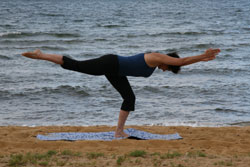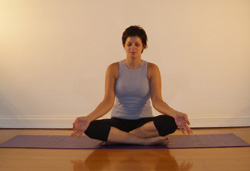About Yoga Yoga dates back thousands of years. It is one of the oldest forms of exercise. Yoga is more than just the healthy acts of movement and breath control—yoga provides a life philosophy based on age-old wisdom. Yoga advocates that all things are connected through an energy known as Prana (life-force). Prana is the vibratory power present in all things. |
 Kate Wiesner in the dancer (Natrajasana). Some schools of yoga refer to it as the warrior III (Virabhadrasana III). |
Physics
Physics explains the presence of this vital energy by way of particles and magnetic fields. In yoga, this energy is the substance of life. The first law of thermodynamics explains that energy cannot be destroy—it can only change form. Yoga is about transformation. It provides ways to improve the essential flow of the natural life-energy contained in the human bodymind.
The Breath
Prana is moved through the body by the breath—yoga asanas (postures) and pranayama (breathing techniques) enhance the flow of prana, allowing the body’s inherent healing processes to take effect. Homeostatis is the goal of modern medicine—a state of balance that allows the body to function at its optimal level. Stress and environmental toxins interfere with our natural homeostatis. Yoga works with the parasympathetic division of the autonomic nervous system (the restorative process that brings the bodymind back to balance)—relaxation response—returning the bodymind to its natural state of equilibrium.
 Kate Wiesner in the easy cross-legged pose (Sukhasana) |
Relaxation Unfortunately today, we are often exposed to the hazardous effects of being in a sustained state of readiness for action, a state which we call stress. This is the fight or flight response (sympathetic division of the autonomic nervous system). In essence, yoga is a ‘science of mind’; it maintains that our physicality is affected by the mind. Simply put, our worries affect our health. Yoga is a counterbalance to this stress. |
Peace
Ethics and morality are often associated with religion, or thought to be altogether absent in today’s world. Yogic philosophy teaches that there are certain natural laws that need to be respected (yama and niyama) to support and enhance our existence. So, yoga not only helps us to function better physically and mentally (through asana [poses], pranayama [controlled breathing] and sadhana [spiritual practices such as meditation]), it also shows us how to behave towards each other—how to live peacefully within our environment. Yoga gives us a ‘pyscho-technology’ for living (Feuerstein 1998).
See also:

